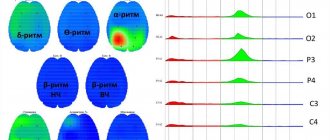Panic syndrome (panic attacks) is a common anxiety disorder. An attack means a strong causeless panic attack, accompanied by vegetative symptoms (palpitations, rapid breathing, trembling, dizziness, even loss of consciousness).
During an attack, a person may seek shelter, rush about, or take unnecessary medications. For some people, panic becomes a constant companion - attacks are repeated for no reason, and nighttime panic attacks occur. This impairs quality of life, and severe panic disorder can be disabling.
Panic disorder is confused with VSD (vegetative-vascular dystonia) and heart disease (attacks of tachycardia). These diseases may be accompanied by a feeling of fear, but it is secondary.
Important
The treatment of panic disorder should be primarily done by a psychotherapist, since the cause of the disorder is in the subconscious. You can fight VSD for years with beta blockers and sedatives, but without psychotherapy, drug methods often turn out to be useless - they treat the effect, not the cause.
Causes
The main reasons for the development of panic disorder are predisposition.
In the mental sphere, predisposition is characterized by such traits as increased suspiciousness and anxiety, a tendency to doubt, lack of self-confidence, and increased attention to health problems.
Biological factors of predisposition to panic attacks: heredity (the presence of persons with mental disorders among blood relatives), disruption of the physiological mechanisms responsible for regulating the exchange of neurotransmitters in the brain.
Social factors: information overload, sleep-wake disturbances, abuse of psychoactive substances, sedatives and sleeping pills.
In addition to the causes, factors that directly trigger a panic attack play an important role: stress, psychological trauma, overwork, hangover or withdrawal symptoms, sleepless night the night before, hormonal changes in the body.
Diagnostics
Before treating an anxiety disorder, the patient must be diagnosed with it. The disease can be diagnosed as the main diagnosis only if all types of phobias are absent, and a panic attack resulting from an established phobic situation is considered an expression of the severity of the phobia, which should be taken into account in the diagnosis first.
In order for the diagnosis to be more reliable, it is necessary to track the frequency of severe attacks. If they occur several times over the course of a month, panic disorder is diagnosed. In this case, you need to take into account:
- that the circumstances surrounding the attack should not be associated with an objective threat;
- that attacks should not be limited to predictable situations;
- that the state between attacks should be relatively free of anxiety symptoms.
Symptoms
The main symptom of this disorder is sudden panic attacks and, subsequently, fear of repetition of these attacks. On average, a panic attack lasts from 5 to 15 minutes.
To be diagnosed with panic disorder, the attack must occur more than once. Symptoms are divided into two groups: feelings of fear and somatic symptoms.
- Feeling of fear. The content of fear can be different, depending on the characteristics of the psyche. The most common options: fear of death, heart attack, suffocation, losing control and going crazy.
- Somatic symptoms. Caused by overexcitation of the autonomic nervous system and changes in perception: palpitations, shortness of breath, heaviness in the chest and other parts of the body, waves of heat or cold throughout the body, dizziness, trembling, derealization, a feeling of loss of control over oneself.
During an attack, the patient is completely overwhelmed by fear, as a rule, seeks help from others, calls an ambulance or a doctor. The arriving doctors, after examining the patient, do not find any signs of illness other than a feeling of fear.
After the panic attack ends, the patient may be afraid for a long time of a recurrence of this unpleasant condition. This is the phenomenon of the so-called “fear of anticipation.”
Panic disorder is characterized by bouts of panic attacks that end in a normal state. A constant feeling of panic is no longer panic disorder, but another disease - generalized anxiety disorder.
Panic disorder - principles of therapy
The main manifestation of PR is repeated paroxysms of anxiety (panic attacks). A panic attack (PA) is an inexplicable, painful attack of fear or anxiety for the patient in combination with various vegetative (somatic) symptoms. In the domestic literature, the term autonomic crisis has been used for a long time, reflecting ideas about the primacy of dysfunction of the autonomic nervous system. It is acceptable to use both terms, although the term “panic attack” has worldwide recognition and is included in the International Classification of Diseases, 10th revision [2]. Diagnosis of a panic attack is based on certain clinical criteria. A panic attack is characterized by paroxysmal fear (often accompanied by a feeling of impending doom) or anxiety and/or a feeling of internal tension in combination with 4 or more of the list of panic-associated symptoms (Table 1). The intensity of the main criterion of PA - paroxysmal anxiety - can vary widely (from a pronounced affect of panic to a feeling of internal tension). In the latter case, when the vegetative component comes to the fore, they talk about “non-insurance” PA or “panic without panic”. Attacks depleted of emotional manifestations are more common in therapeutic and neurological practice. The criterion of the presence of at least 4 symptoms from the list in an attack is not absolutely strict. As a rule, patients, along with “full-scale” attacks, experience more frequent “minor” attacks, limited to 2-3 symptoms. In addition to the symptoms presented in the list, the attack may include other symptoms, most often the so-called conversion ones (sensation of a lump in the throat; gait disturbance; visual or hearing impairment; cramps in the arms or legs, pseudoparesis, etc.). But the presence of more than 5-6 atypical (non-panic-associated) symptoms during an attack casts doubt on the diagnosis of PA. Panic-associated symptoms develop suddenly and reach their peak within 10 minutes. The post-attack period is characterized by general weakness and weakness. The duration of the attack is also an important diagnostic criterion. The short duration of the paroxysm argues against the diagnosis of PA. The duration of PA is calculated in minutes, on average 15–30 minutes. Although some patients report longer attacks. There is a direct relationship between the presence of an atypical radical in an attack and its duration. Assessing attack triggers can also help with diagnosis. Most patients report spontaneous (unprovoked) attacks. However, active questioning of the patient makes it possible to identify, along with spontaneous attacks, situational attacks that occur in potentially “threatened” situations. Such situations may be using transport, being in a crowd or confined space, the need to leave your own home, etc. Stress factors are also considered as important provocateurs of PA. Classic biological provocateurs of PA are infusion of sodium lactate, inhalation of 5–35% CO2, and hyperventilation. In addition, PA can be triggered by alcohol intake, insufficient sleep, and menstruation. Very rarely, panic occurs in response to unexpected stimuli of various modalities (a knock on the door, a phone ringing, an unexpected touch, etc.), which is interpreted by some researchers as a kind of startle reaction. PAs occur predominantly during wakefulness (during the daytime or evening). However, in some patients, in addition to daytime attacks, there are also nighttime attacks that arise from sleep. It is extremely rare for patients to have only sleep PA. Based on polysomnographic studies, it has been established that sleep PAs occur during the slow phase of sleep, usually in late 2nd or early 3rd stages of sleep. The frequency of attacks varies widely within the patient population. Attacks can be observed as isolated phenomena, and at the same time, in some patients they occur several times a day. Moreover, in the case of daily deployed attacks, as a rule, there are 3–5 small attacks per deployed PA. Panic attacks are not a nosologically specific phenomenon. A one-time occurrence of PA cannot be considered from the perspective of a disease at all. It is believed that most people, under certain circumstances, experience this dramatic phenomenon at least once in their lives. In this case, PA represents a physiological response to emotional stress. PA can occur in somatic as well as mental illnesses, especially depressive disorders. But most often doctors encounter the phenomenon of PA within the framework of panic disorder. The ICD-10 diagnostic criteria [2] for panic disorder contain the following points: 1. Recurrence of panic attacks. 2. Panic attacks for a month or more are accompanied by symptoms such as: – constant concern about the recurrence of attacks; – concern about complications of attacks or their consequences (loss of self-control, severe organ pathology); – significant changes in behavior associated with attacks. 3. The occurrence of attacks is not caused by the direct action of any substances or somatic diseases (arrhythmia, thyrotoxicosis, hypertensive crisis, coronary heart disease, etc.). PR has a special stereotype of the formation and development of symptoms. The first attacks leave an indelible mark on the patient’s memory, which leads to the appearance of an anxiety syndrome of “anticipation” of an attack, which, in turn, perpetuates the repetition of attacks. Repeating attacks in similar situations (in transport, being in a crowd, etc.) contributes to the formation of restrictive behavior, i.e. avoiding places and situations that are potentially dangerous for the development of PA. Anxiety about the possible development of an attack in a certain place (situation) and avoidance of this place (situation) is defined as agoraphobia (from the Greek agora - area, phobia - fear). The increase in agoraphobic symptoms leads to social maladjustment of the patient. Due to fear, patients are unable to leave home or remain alone. The presence of agoraphobia in PD indicates a more severe course of the disease, a worse prognosis and requires special therapeutic tactics. Apparently, the stereotype of the development of panic disorder, discussed above, is not universal and, obviously, there are several options that differ from each other in the dynamics of the appearance of symptoms of PA, anticipatory anxiety and agoraphobia. As PD progresses, the disease may be complicated by the appearance of symptoms of depression. Many researchers have proven that when PD and depression are combined, both disorders manifest themselves in a more severe form. In general, PR is characterized by a high frequency of comorbid conditions (Table 2), which generally aggravate the prognosis and reduce the likelihood of remission. The comorbidity of PD with psychopathological syndromes tends to increase with the duration of the disease. Insomnia to one degree or another is characteristic of the vast majority of patients with PR. A special study we conducted showed that in patients with PR, all subjective characteristics of sleep were changed in a pathological direction: overall quality of sleep, speed of falling asleep, depth of sleep, sleep duration, and others [3]. Very often, sleep disturbances precede the onset of PA. This is especially true for patients with nocturnal PA. The sleep of patients with PD is characterized by a number of signs of increased activity of nonspecific activating influences (extension of time to fall asleep, decrease in total sleep duration, decrease in delta sleep content, decrease in the production of sleep spindles and delta waves). Finally, inadequate and untimely treatment measures contribute to the chronicity of PR. Anxiety disorders, including panic, are diagnosed in only 50% of patients with obvious symptoms [4]. Less than 50% of patients receive any treatment and less than 30% receive adequate therapy. Despite the obligatory nature of autonomic dysfunction during an attack and the often masked nature of emotional disorders, the basic method of treating PD is psychopharmacological treatment. However, it would be incorrect to associate the severity and chronicity of ADR only with diagnostic and therapeutic errors, since ADR tends to become chronic even despite adequate treatment [5]. Nevertheless, it is extremely important to promptly and correctly diagnose PR and apply the most appropriate therapeutic tactics possible. When determining treatment tactics for patients, they primarily compare the benefits of treatment with the risks of it. Risk factors for pharmacotherapy include side effects, complications during therapy, and difficulties in discontinuing the drug. The benefits of treatment are the restoration of health, social functioning of the patient and the ability to prevent relapses. Selective serotonin reuptake inhibitors (SSRIs), tricyclic antidepressants (TCAs), and high-potency benzodiazepines (HBPs) such as alprazolam and clonazepam have been shown to have antipanic effects in many studies compared with placebo (Table 3). SSRIs are gradually replacing TCAs and benzodiazepines in the treatment of PR and are beginning to occupy a leading position. Currently, SSRIs are recognized by most researchers and practitioners as the first-line drugs of choice for the treatment of panic disorder. This provision is based on the undoubted antipanic effectiveness and good tolerability of drugs in this group. The undeniable advantage of SSRIs is their high effectiveness against agoraphobia, superior to classical TCAs. Of course, like any antidepressants, they affect depressive disorders. Often this category of patients has massive sleep disturbances. Among SSRIs, the leader in hypnogenic effect is fluvoxamine (Fevarin), due to its additional effect on sigma-1 receptors [6]. The effect of fluvoxamine on anxiety and insomnia develops rapidly during the first week, which brings significant relief to the patient. The benefits of this drug in patients with nocturnal panic attacks should be especially emphasized. Effects on sigma-1 receptors likely explain the potential benefits of fluvoxamine against hypochondriacal symptoms, also common in chronic panic disorder. In addition to the above, Fevarin has a pronounced analgesic effect, which, combined with its antidepressant effect, high safety and ease of administration (1 t./day - 100 mg), makes Fevarin the drug of choice for patients with anxiety and insomnia in combination with chronic pain syndromes ( in particular with chronic daily headaches). Benzodiazepine drugs are highly effective against PA itself. High-potency benzodiazepines can both stop an attack and control the progression of an attack. Moreover, the effect of VPB does not depend on the type of attack (typical, atypical, respiratory). Also, VPBs are able to block PA caused by physiological agents (lactate, carbon dioxide inhalation, cholecystokinin) both in patients with PR and in healthy people. These data support the hypothesis of the nonspecific participation of GABAergic systems in the development and control of panic and other paroxysmal states. In addition to controlling PA, benzodiazepines are also highly effective against anticipatory anxiety. However, these drugs are less effective in relieving agoraphobic disorders than SSRIs (Fevarin) and TCAs. The effect on depressive disorders in VPB is also less pronounced. The indisputable advantage of VPB is the rapid onset of effect. Control of PA on the ISP is achieved after a few days, while ADs show their effectiveness after several weeks. As a rule, by the end of the first week of treatment, the advisability of further taking the medication becomes clear. The absence of deterioration of the condition of VPB, characteristic of TCAs, at the initial stage of therapy is also one of the significant advantages of this class of drugs. The most significant problem in the use of VPB is the development of addiction and dependence, which makes long-term use of these drugs impossible. Treatment should only be started when the patient has recurrent attacks and anticipatory anxiety. In clinical practice, the severity of ADR is the most important criterion for choosing a therapeutic strategy. Before starting treatment, it is necessary to assess the frequency of PA, the degree of agoraphobia, the presence and severity of comorbid disorders (depression, anxiety, personality disorders), as well as previous treatment. When isolated PA appears, small, fixed doses of daily anxiolytics can be used, prescribed in short courses (no more than 3–4 weeks). “Mild” PR (relatively rare attacks not accompanied by persistent “avoidant” behavior) allows monotherapy with VPB. As the clinical picture becomes more complex and PR becomes chronic, the effectiveness of therapy with benzodiazepine derivatives decreases. “Extended” PR (more than 4 PAs, obvious anticipatory anxiety, agoraphobia that disrupts social adaptation; mild or moderate comorbid depressive disorder) requires monotherapy for several months (3–4). The choice of the class of the basic drug is determined by a set of the following factors: side effects, time of onset of the effect, the presence of concomitant syndromes (sleep disturbance, agoraphobia, depression, generalized anxiety), fear of developing withdrawal syndrome. Most clinicians adhere to the following standard of treatment for full-blown PR: • long-term prescription (several months) of a drug from the SSRI group Fevarin, unlike other antidepressants from the SSRI group, is distinguished by the onset of a rapid calming, anti-anxiety effect; • adding a benzodiazepine drug during the initial 2–4 weeks of treatment as an effective “bridge” until the desired effect of the SSRI is achieved [7]. Prescribing short courses of benzodiazepines to patients with PR is justified at the beginning of AD therapy - this helps to reduce the deterioration of the clinical picture that occurs in some patients during the initial period of AD therapy. In addition, while taking anxiolytics, the patient calms down, more easily agrees with the need to wait for the development of the antipanic effect of SSRIs, and better complies with the therapeutic regimen (compliance improves). In case of severe PR [high frequency of attacks (more than 10); severe agoraphobia leading to social maladjustment (job loss); comorbidity with major depressive disorder, alcohol and/or drug abuse, social phobia, generalized anxiety, personality disorder] pharmacotherapy should always be the first step, but with the further intention of using cognitive behavioral psychotherapy (the so-called sequential strategy). A combination of two drugs, VPB and SSRI/TCA, is mandatory at the initial stage. Prescribing psychotherapy simultaneously with medication at the initial stages of treatment may be useless, since a patient with frequent, widespread PA under the pressure of the severity of his condition cannot adequately participate in psychotherapeutic sessions. In the future, when an improvement in the clinical picture is achieved with drug therapy, the addition of cognitive therapy can greatly improve the overall outcome of treatment. The severity of the clinical picture requires long-term (a year or more) courses of treatment. Both pharmacological factors (inadequately short course of therapy, low doses of the basic drug, poor tolerability of the drug, noncompliance) and factors associated with the disease itself (presence of comorbid PR conditions, increased sensitivity) lead to the chronicization of PR and therapeutic resistance. ). Epidemiological studies show that about 40% of patients with PR do not take medications, although they have been consulted by a doctor and therapy is recommended. Only two thirds of patients receive treatment at adequate doses and duration. These facts confirm the need for active interaction between the doctor and the patient, clarification of the goals and strategy of therapy, as well as discussion of a favorable prognosis of the disease while observing the therapy regimen.
References 1. Perkonigg A, Wittshen HU. Epidemiologie von Angststorungen. // In: Kaster S, Muller HJ, eds. Angst– und Panikerkrankung. Jena: Gustav Fischer Verlag, 1995; 137–56 2. International classification of diseases (10th revision). Classification of mental and behavioral disorders. WHO/Translated from English. edited by Nuller Yu.L., Tsirkin S.Yu. Russia., S–P., "ADIS". 1994 3. Bashmakov M.Yu. Panic attacks in the sleep-wake cycle (clinical and psychophysiological study): dissertation. Ph.D. honey. Sciences, 1995, 132 p. 4. Sartorius N, Ustun TB, Lecrubier Y, Wittchen HU. Depression comorbid with anxiety: results from the WHO study on psychological disorders in primary health care. Br J Psychiatry 1996; 168: 38–43 5. Katschnig H, Stolk JM, Klerman GL, et al. Discontinuation and long–term follow–up of participants in a clinical drug trial for panic disorder. Biol Psychiatry 1992; 1:657–660 6. Stahl SM. Essential psychopharmacology: the prescriber's guide: antidepressants. Cambridge University Press 2006 7. Sheehan DV. The management of panic disorder. J Clin Psychiatry 2002;63 Suppl 14:17–21.
Treatment
This disease is one of the most benign in psychiatry and has a good prognosis with adequate therapy.
The most effective treatment methods:
- Drug therapy: tranquilizers, antidepressants, neurometabolic therapy, mood stabilizers and neuroleptics.
- Psychotherapy: cognitive therapy, psychodynamic methods.
- Biofeedback therapy.
- Physiotherapy.
- Exercise therapy, massage, reflexology.
How to quickly help
Find out more about how you can relieve a panic attack at home and using improvised means here.
Treatment of panic disorder at the ROSA Clinic:
- Quick relief from a panic attack. Prevention of recurrence of attacks.
- Examination of the nervous system and mental sphere. Identifying the causes of the disease.
- Safe medicinal, psychotherapeutic and non-medicinal therapy methods.
- Own hospital.
- Around the clock.
- Anonymously. We don't register.
Progression and consequences of lack of treatment measures
Intensive, well-chosen therapy allows you to quickly achieve positive dynamics and improve your emotional state. But what happens if you ignore the problem and hope that everything will resolve itself?
First of all, it is worth noting that panic or anxiety syndromes themselves are quite normal. Man is a biosocial being, overwhelmed by a whole spectrum of feelings and emotions. And here it is very important to distinguish between two states: banal concern about some event and a real anxiety attack. If seizures become systematic, one should not hope that they will disappear over time. The longer you ignore what is happening, the worse the situation will become.
What exactly happens if there is no proper treatment program that can improve mental balance?
- “isolation of affect” is formed when attacks cease to cause fear, while simultaneously reducing the quality of life;
- Nervous exhaustion occurs, often leading to serious health problems;
- the number of seizures increases, and the intervals between them become shorter and shorter.
Women are especially susceptible to progression, and therefore must pay more attention to their condition. In rare cases, refusal to take medications and participate in psychological consultations becomes the cause of the development of other, no less serious pathological processes.
Self-medication
Many people do not seek help from doctors until the very end, preferring a variety of self-medication practices. Of course, in some cases you can solve the problem yourself, but there is a high probability of developing negative side effects and syndromes. That is why experts highly recommend making an appointment with a neurologist at the first symptoms. A timely examination will allow you to quickly understand the cause of the disease and create a suitable recovery program.
It was already noted above that the same treatment sometimes gives completely different results: someone will feel relief and calm down, while others, on the contrary, will receive a new outbreak of tension. That is why a thorough diagnostic analysis is required, aimed at studying adaptive, mental and neurological functions. As a rule, specialists give an appointment for blood donation, conduct a consultation, and collect anamnesis. The listed activities allow you to most accurately select rehabilitation and recovery measures that help achieve positive dynamics.
Remember: you are at risk every time you resort to self-medication. Only a doctor is able to correctly determine the diagnosis and correctly prescribe medications. Therefore, do not be lazy to visit specialized institutions, take tests and undergo examinations.
Preventive measures
Those who properly carry out all the tasks of the attending physician quickly achieve positive changes and can even count on remission. But therein lies the main catch. Many people mistakenly believe that if panic attacks have subsided for a month, they will not return in the future, and therefore they stop following the instructions of the neurologist. The result is a serious relapse.
Prevention can help avoid this, including:
- adherence to sleep and rest patterns;
- sufficient fluid intake (you can also drink soothing teas - green, mint, etc.);
- refusal of overwork, overwork;
- proper diet enriched with healthy vitamins and microelements;
- regular and timely consultations with a specialist;
- taking maintenance medications (only as directed by a doctor!);
- breathing exercises (they help relieve psychological pressures, take a break from everyday hustle and bustle and routine, relax, put your thoughts in order);
- meditation (another way to relax after a grueling workday);
- exclusion of external factors that can plunge you into a stressful state.
By following the above points, you will ensure the proper stability of remission and prevent the occurrence of new panic attacks and attacks.
Outpatient program, remission
Those who decide to undergo outpatient treatment are recommended to participate in activities designed to help them re-adapt and socialize into society and improve their overall quality of life. They cope well with the following tasks:
- socio-centered methods of psychotherapy;
- family or vocational rehabilitation;
- supportive therapy (can be either group or individual - it all depends on the emotional characteristics and personal preferences of the patient);
- regular follow-up with a specialist.
Of course, we must not forget about the principles of a healthy lifestyle and proper nutrition. They also help to achieve positive dynamics. Compliance with all requirements, advice and recommendations brings the patient closer to stable, high-quality remission. However, you should not think that with its onset you will completely get rid of the problem. Since PA is chronic, PA may recur in the event of unhealthy behavior. The main reason for failure of therapeutic remission is repeated psychotraumatization. And although a number of experts find it unconvincing, the statistics speak for themselves.
Why does anxiety disorder occur?
As in the case of most mental disorders, no one can say exactly why anxiety clings to us: too little is known about the brain to talk about the reasons with confidence. Several factors are likely to blame, from ever-present genetics to traumatic experiences.
For some, anxiety appears due to the stimulation of certain parts of the brain, for others, hormones - serotonin and norepinephrine - are acting up, and for others, the disorder occurs as a result of other diseases, and not necessarily mental ones.






